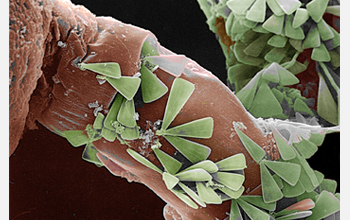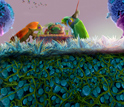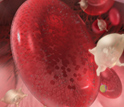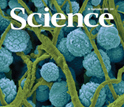News Release 08-163
2008 Science and Engineering Visualization Challenge Winners Announced
Winning entries will appear in Sept. 26 issue of Science
September 25, 2008
This material is available primarily for archival purposes. Telephone numbers or other contact information may be out of date; please see current contact information at media contacts.
The National Science Foundation (NSF) along with the journal Science, published by the American Association for the Advancement of Science (AAAS), today announced the winners of their sixth annual International Science & Engineering Visualization Challenge.
The winning entries included breathtaking photographs and graphics that reveal intricate details of our world--the three-dimensional path made by a rapidly spinning string cutting through space and the unique anatomy of the half-meter-long Loligo pealei squid whose tiny suckers are 400 micrometers in diameter.
"I wanted to reveal the tiny world we trample through, creating scenes that at first glance are parallel to our macroscopic world, until you look a little closer," said Colleen Champ, a first-place winner with Dennis Kunkel in the Informational Graphics category. "The ‘Mad Hatter's Tea' is one scene from many, depicting a quote from the fanciful mind of Lewis Carroll," she added. This scene will be featured on the cover of the Sept. 26, 2008, issue of Science.
Illustrators, photographers, computer programmers and graphics specialists from around the world were invited to submit visualizations that would intrigue, explain and educate. More than 180 entries were received from 21 countries.
The winning entries communicate information about the creation of spontaneous buckling of a poly(ethylene glycol) layer resembling wrinkles that appear on flowers' petals and leaves' edges; the 3D rendering, at nanometer resolution, of a melanoma cell through ion abrasion electron microscopy; the display of microbial biofilm from a stream, explaining its role within the stream's micro-ecosystem; and, more. The Sept. 26, 2008, issue of Science will feature the winning entries, which will also be freely available at http://www.sciencemag.org/vis2008/ and the NSF's website at http://www.nsf.gov/news/special_reports/scivis/.
-NSF-
-
"Mad Hatter's Tea" won first place in Informational Graphics.
Credit and Larger Version -
"Zoom into the Human Bloodstream" won first place in Illustration.
Credit and Larger Version -
The September 26, 2008 issue of Science will feature the winning entries.
Credit and Larger Version
The 2008 winning entries are included in the following five categories:
PHOTOGRAPHY
First Place:
Mario De Stefano, The Second University of Naples
The Glass Forest
Honorable Mentions (tie):
Andrew Davidhazy, Rochester Institute of Technology
String Vibrations
Jessica D. Schiffman and Caroline L. Schauer; Drexel University
Squid Suckers: The Little Monsters That Feed the Beast
Ye Jin Eun and Douglas B. Weibel; University of Wisconsin-Madison
Polymazing
ILLUSTRATION
First Place:
Linda Nye and the Exploratorium Visualization Laboratory; The Exploratorium
Zoom Into the Human Bloodstream
Honorable Mentions (tie):
Chris Harrison, Carnegie Mellon University; Christoph Römhild, North Elbian Evangelical Lutheran Church
Visualizing the Bible
Donald Bliss and Sriram Subramaniam; National Library of Medicine, NIH
3D Imaging of Mammalian Cells with Ion-Abrasion Scanning Electron Microscopy
INFORMATIONAL GRAPHICS
First Place:
Colleen Champ and Dennis Kunkel; Concise Image Studios
"Mad Hatter's Tea" from Alice's Adventures in a Microscopic Wonderland
Honorable Mention:
Andrew Dopheide and Gillian Lewis; University of Auckland
Stream Micro-Ecology: Life in a Biofilm
INTERACTIVE MEDIA
First Place:
Jeremy Friedberg and Tommy Sors; Spongelab Interactive
Genomics Digital Lab: Plant Cells
Honorable Mention:
Janet Iwasa; Massachusetts General Hospital
Exploring Life's Origins
NON-INTERACTIVE MEDIA
Honorable Mentions (tie):
Travis Vermilye and Kenneth Eward
A Window Into Life
Mirjam Kaplow and Katharina Strohmeier; Fraunhofer FIRST
Smarter than the Worm
Etsuko Uno and Drew Berry; The Walter and Eliza Hall Institute of Medical Research
Fighting Infection by Clonal Selection
Media Contacts
Dana Topousis, National Science Foundation, (703) 292-7750, email: dtopousi@nsf.gov
Natasha Pinol, AAAS, (202) 326-7088, email: npinol@aaas.org
Program Contacts
Susan Mason, National Science Foundation, (703) 292-7748, email: smason@nsf.gov
The U.S. National Science Foundation propels the nation forward by advancing fundamental research in all fields of science and engineering. NSF supports research and people by providing facilities, instruments and funding to support their ingenuity and sustain the U.S. as a global leader in research and innovation. With a fiscal year 2023 budget of $9.5 billion, NSF funds reach all 50 states through grants to nearly 2,000 colleges, universities and institutions. Each year, NSF receives more than 40,000 competitive proposals and makes about 11,000 new awards. Those awards include support for cooperative research with industry, Arctic and Antarctic research and operations, and U.S. participation in international scientific efforts.
Connect with us online
NSF website: nsf.gov
NSF News: nsf.gov/news
For News Media: nsf.gov/news/newsroom
Statistics: nsf.gov/statistics/
Awards database: nsf.gov/awardsearch/
Follow us on social
Twitter: twitter.com/NSF
Facebook: facebook.com/US.NSF
Instagram: instagram.com/nsfgov






